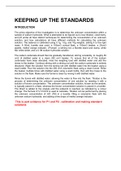KEEPING UP THE STANDARDS
INTRODUCTION
The prime objective of the investigation is to determine the unknown concentration within a
sample of sodium hydroxide. What is attempted to be figured out is how titration, colorimetry,
and pH probe all have distinct techniques for determining the concentration of an unknown
solution, and how calculations all have different methods for calculating the unknown
solution. The balance is calibrated using 0.1g, 1.0g, and 10g weights, setting it to the right
mass. A 50mL burette was used, a 100cm3 conical flask, a 100cm3 beaker, a 25cm3
pipette, methyl orange indicator, i-Pumper, a stirring rod, a Burette stand and clamp, white
tile/ white sheet, and a 0.1M sodium hydroxide solution.
The sodium carbonate should then be gradually transferred, stirring constantly, to roughly 50
cm3 of distilled water in a clean 250 cm3 beaker. To ensure that all of the sodium
carbonates have been allocated, rinse the weighing boat with distilled water and add the
rinses to the beaker. Continue stirring with a stirring rod until the sodium carbonate is entirely
dissolved. Wash the solution from the stirring rod with distilled water into the beaker using a
wash bottle. Pour the solution into the 250 cm3 volumetric flask using a clean funnel. Rinse
the beaker multiple times with distilled water using a wash bottle, then add the rinses to the
solution in the flask. Make sure the funnel is clean by rinsing it with distilled water.
Rinse the funnel with distilled water, allowing the water to flow into the flask. Titration is the
process of determining the unknown concentration of one solution by reacting it with a
solution of known concentration. The unknown concentration solution, known as the analyte,
is typically placed in a flask, whereas the known concentration solution is placed in a burette.
The titrant is added to the analyte until the endpoint is reached, as indicated by a colour
change. The formula C1V1=C2V2 is used to calculate. Titration can be performed by placing
the unknown concentration of HCl (1M) in a burette, filling a volumetric flask with the
unknown sodium hydroxide, and adding a few drops of methyl orange indicator.
This is part evidence for P1 and P2 - calibration and making standard
solutions
,STANDARD SOLUTION AND TITRATION
AIM
To prepare a standard solution, first properly measure 1.45 g of anhydrous sodium
carbonate on a weighing boat with a balance
This aim is to first make a standard sodium carbonate solution. This solution will then be
titrated with sodium carbonate to determine the concentration of the sodium carbonate by
reading the graph and determining the volume required for neutralisation to occur, then
using the results to determine the unknown concentration of the sodium carbonate.
Before starting the procedure to make titration, the solution that is used to make titration
must be made.
This is done by:
Weigh 1.45g sodium carbonate into a weighing boat.
Transfer this to a beaker and cleanse this so the excessed amount of the sodium
carbonate is removed and poured into the very same beaker.
This is encouraged so that the exact mass of Na₂CO₃ is unchanged.
Grab a pipette and its Pi-pumper and always make sure that the pipette is
thoroughly rinsed with distilled water.
Hold the pipette at the top and gently put it into the Pi pump by pressing gently
and twisting slightly.
Dip the tip of the pipette into the solution. Raise the amount of liquid above the
pipette's graduation point with the thumbwheel. Maintaining the tip of the pipette
in the liquid prevents air bubbles from being sucked up and liquid from being
dragged into and contaminating the filler.
Look at the graduation mark at eye level. Reduce the liquid until the bottom of the
meniscus is level with the graduation mark.
Carefully transfer the pipette to the chosen receptacle (e.g. conical flask) and
expel the liquid using the release lever valve.
This is part evidence for M1 - Skilful application and techniques in
titration.
CALCULATION
1. Equation: Na₂CO₃+ 2HCL –> 2NaCl + H2O
2. Concentration of Na₂CO₃= 0.025/250 x 1000 = 0.1 mol dm-3
3. Moles of Na₂CO₃ in 250 cm-3 = 0.025, moles in 25cm-3 = 0.025/10 = 0.0025
This reaction shows that 1 mol of NaOH will react with 1 mol of HCL to produce 1 mol of salt
(NaCl) and 1 mole of water.
This is part evidence for P2 - calculation of moles in standard solution
, RISK ASSESSMENT
Risk Hazard Level Precaution Emergency
Severe eye Sodium Medium-Wear goggles -Rinse eyes for
irritation is carbonate(anhydrous several minutes with
possible. solid) -Avoid contact water.
Glassware Breaking/Stabbing Low Handle Carefully – If damaged, do not
approach.
Weighing scalesElectric shock Low Do not touch the If you are shocked,
exposed get immediate
conductors. treatment.
This is evidence for D1 - Hazards and risks associated with analytical
techniques and procedures.
HEALTH AND SAFETY
Proper trash disposal
Determine safety equipment
Do not inhale the chemicals.
Experiments should be left at the lab.
Wear goggles at all times.
Wear a safety coat
Wear a glove when making contact with substances that are unknown to your nature
make sure to keep long hair in a bun.
TITRATION OF HYDROCHLORIC ACID




